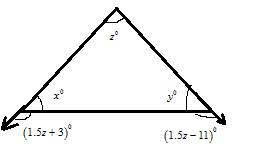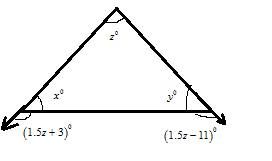
Concept explainers
The values of
Answer to Problem 64E
The solution is
Explanation of Solution
Given:
The triangle is shown below as,

Formula used:
The equation is formed with three linear variables. The sum of three angles in the triangle is 180°.
Calculation:
Consider the below triangle

Forming the equations with three variables, In triangle sum of three angles is 180°, therefore
This system can be solved by using row operations as shown below,
Multiply the first equation by -1 and add it to the second equation to produce a new second equation
Now the system with new second equation is
Add second equation to third equation to get new third equation
Divide the third equation by 2; the system is
Thus from the third equation
Back substitute this value in 2nd equation to get the value of y
Back substitute
Hence the solution is
Conclusion:
The solution is
Chapter 7 Solutions
EBK PRECALCULUS W/LIMITS
- (1) (14 points) Let a = (-2, 10, -4) and b = (3, 1, 1). (a) (4 points) Using the dot product determine the angle between a and b. (b) (2 points) Determine the cross product vector axb. (c) (4 points) Calculate the area of the parallelogram spanned by a and b. Justify your answer. 1arrow_forward(d) (4 points) Think of this sheet of paper as the plane containing the vectors a = (1,1,0) and b = (2,0,0). Sketch the parallelogram P spanned by a and b. Which diagonal of P represents the vector ab geometrically? d be .dx adjarrow_forward(2) (4 points) Find all vectors v having length 1 that are perpendicular to both =(2,0,2) and j = (0,1,0). Show all work. a=arrow_forward
- For the following function, find the full power series centered at a of convergence. 0 and then give the first 5 nonzero terms of the power series and the open interval = f(2) Σ 8 1(x)--(-1)*(3)* n=0 ₤(x) = + + + ++... The open interval of convergence is: 1 1 3 f(x)= = 28 3x6 +1 (Give your answer in help (intervals) .)arrow_forwardFor the following function, find the full power series centered at x = 0 and then give the first 5 nonzero terms of the power series and the open interval of convergence. f(x) = Σ| n=0 9 f(x) = 6 + 4x f(x)− + + + ++··· The open interval of convergence is: ☐ (Give your answer in help (intervals) .)arrow_forwardLet X be a random variable with the standard normal distribution, i.e.,X has the probability density functionfX(x) = 1/√2π e^-(x^2/2)2 .Consider the random variablesXn = 20(3 + X6) ^1/2n e ^x^2/n+19 , x ∈ R, n ∈ N.Using the dominated convergence theorem, prove that the limit exists and find it limn→∞E(Xn)arrow_forward
- Let X be a discrete random variable taking values in {0, 1, 2, . . . }with the probability generating function G(s) = E(sX). Prove thatVar(X) = G′′(1) + G′(1) − [G′(1)]2.[5 Marks](ii) Let X be a random variable taking values in [0,∞) with proba-bility density functionfX(u) = (5/4(1 − u^4, 0 ≤ u ≤ 1,0, otherwise. Let y =x^1/2 find the probability density function of Yarrow_forward2. y 1 Ο 2 3 4 -1 Graph of f x+ The graph gives one cycle of a periodic function f in the xy-plane. Which of the following describes the behavior of f on the interval 39 x < 41 ? (Α B The function f is decreasing. The function f is increasing. The function f is decreasing, then increasing. D The function f is increasing, then decreasing.arrow_forwardDepth (feet) 5- 4- 3- 2. WW www 1 D B 0 10 20 30 40 50 60 70 80 Time (hours) x A graph of the depth of water at a pier in the ocean is given, along with five labeled points A, B, C, D, and E in the xy-plane. For the time periods near these data points, a periodic relationship between depth of water, in feet, and time, in hours, can be modeled using one cycle of the periodic relationship. Based on the graph, which of the following is true? B C The time interval between points A and B gives the period. The time interval between points A and C gives the period. The time interval between points A and D gives the period. The time interval between points A and E gives the period.arrow_forward
- A certain type of machine produces a number of amps of electricity that follows a cyclic, periodically increasing and decreasing pattern. The machine produces a maximum of 7 amps at certain times and a minimum of 2 amps at other times. It takes about 5 minutes for one cycle from 7 amps to the next 7 amps to occur. Which of the following graphs models amps as a function of time, in minutes, for this machine? A B C D Amps M 3 4 5 678 Minutes Amps w 3 4 5 6 7 8 Minutes 8 Amps- 6+ Amps y 2345678 Minutes 456 8 Minutesarrow_forward5 4. ·3. -2+ 1+ AN -5 -3 -4- 1 x 3 ད Graph of f The graph of the function f is given in the xy- plane. Which of the following functions has the same period as f? A B ми warrow_forwarda C d 2 1 -1 0 1 2 3 -1 Graph of f'(x) (5) The graph of f'(x), the derivative of f(x), is shown in the figure above. The line tangent to the graph of f'(x) at x=0 is vertical and f'(x) is not differentiable at x = 1. Which of the following statements is true? (a) f'(x) does not exist at x = 0. (b) f(x) has a point of inflection at x = 1. (c) f(x) has a local maximum at x = 0. (d) f(x) has a local maximum at x = 1.arrow_forward
 Calculus: Early TranscendentalsCalculusISBN:9781285741550Author:James StewartPublisher:Cengage Learning
Calculus: Early TranscendentalsCalculusISBN:9781285741550Author:James StewartPublisher:Cengage Learning Thomas' Calculus (14th Edition)CalculusISBN:9780134438986Author:Joel R. Hass, Christopher E. Heil, Maurice D. WeirPublisher:PEARSON
Thomas' Calculus (14th Edition)CalculusISBN:9780134438986Author:Joel R. Hass, Christopher E. Heil, Maurice D. WeirPublisher:PEARSON Calculus: Early Transcendentals (3rd Edition)CalculusISBN:9780134763644Author:William L. Briggs, Lyle Cochran, Bernard Gillett, Eric SchulzPublisher:PEARSON
Calculus: Early Transcendentals (3rd Edition)CalculusISBN:9780134763644Author:William L. Briggs, Lyle Cochran, Bernard Gillett, Eric SchulzPublisher:PEARSON Calculus: Early TranscendentalsCalculusISBN:9781319050740Author:Jon Rogawski, Colin Adams, Robert FranzosaPublisher:W. H. Freeman
Calculus: Early TranscendentalsCalculusISBN:9781319050740Author:Jon Rogawski, Colin Adams, Robert FranzosaPublisher:W. H. Freeman
 Calculus: Early Transcendental FunctionsCalculusISBN:9781337552516Author:Ron Larson, Bruce H. EdwardsPublisher:Cengage Learning
Calculus: Early Transcendental FunctionsCalculusISBN:9781337552516Author:Ron Larson, Bruce H. EdwardsPublisher:Cengage Learning





